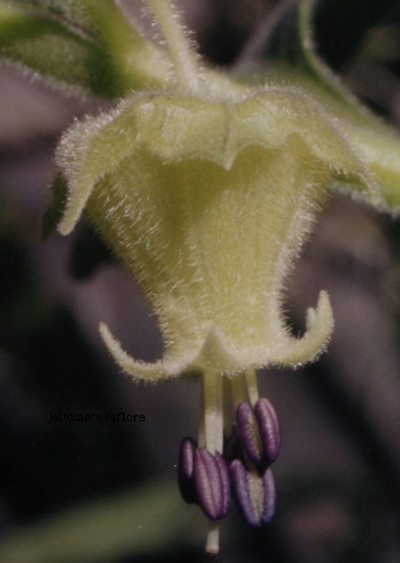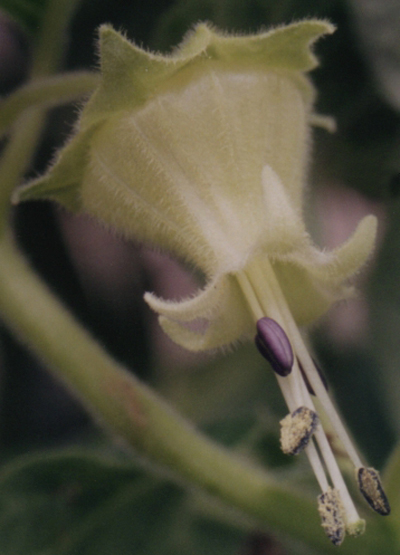

| Protogyny in the genus Jaltomata (Solanaceae) |
The information on this page may be cited as a communication with professor Thomas Mione, Central Connecticut State University, Biology Department, Copernicus Hall, 1615 Stanley Street, New Britain, CT 06050-4010 |
Link to Jaltomata home page |
| Most Jaltomata species seem to be protogynous. Anthers remain undehisced during the first day that the corolla is open, and then dehisce the next day. Details vary among species. In the following pair of J. biflora photos a day-one flower is on the left (anthers all undehisced) and a day-two flower is on the right (at least three of the anthers dehisced). Photos by T. Mione of plant grown in Connecticut. |
 |
 |
Species that seem to be protogynous species include: J. auriculata (for a few hours, Mione 1992), J. bicolor*, J. biflora (Mione et al. 2001), J. cajacayensis*, J. chihuahuensis (Mione & Bye 1996, footnote on p. 80), J. confinis*, J. grandiflora (Mione 1992), J. leivae**, J. lojae (Mione & Serazo, 1999), J. paneroi (for a few hours, Mione & Leiva 1997), J. procumbens (Davis 1986), J. propinqua*, J. repandidentata (Mione & Yacher 2005), J. salpoensis*, J. sinuosa (as J. glandulosa in Mione 1992), J. ventricosa**, J. yacheri*, J. 642*, J. 647*, 718 "TallosNegros"***
Not protogynous: J. darcyana (Mione & Yacher 2005), J. lezamae (Mione unpublished, data from three flowers, year 2000, cultivated in CT), J. sagastegui (Mione & Coe 1996).
* unpublished; the evidence of protogyny is that some of the flowers are fully open and have undehisced anthers and some flowers are fully open and have dehisced anthers, determined from photos having anthers in clear focus and/or flowers preserved in ethanol. Protogyny would be confirmed if stigma of flower having undehisced anthers is pollinated (emasculated and bagged to exclude visitors) and then flower sets fruit.
** unpublished; the evidence of protogyny is that flowers with partially open corollas, corollas in the process of opening, have a protruding stigma and undehisced anthers, determined from photos I took. Protogyny would be confirmed if stigma of partially open corolla is pollinated and then flower sets fruit.
***unpublished; the evidence of protogyny is that when the type specimen was collected in Peru, some of the flowers were fully open and had undehisced anthers, and some flowers were fully open and had dehisced anthers (see 718's field notes).
Jaltomata procumbens
Photo by T. Mione in Connecticut. |
Using the black/purple fruited, herbaceous clade of Jaltomata as an outgroup for the red/orange fruited clade, absence of protogyny and decrease of the duration of protogyny are derived conditions. In the red/orange fruited clade non-protogynous species and short-duration protogynous species have relatively small flowers compared to the species having periods of protogyny one or more days in duration. The opposite trend also exists, with an apparent increase in the duration of protogyny (to a period greater than one day) present in J. umbellata. Notably, during the (initial) pistillate phase of one to two days the corolla is closed except for the protruding style, and no reward is available during this.
In several Jaltomata species filaments elongate a day after the flower first opens and then anthers dehisce (photo immediately above). This dichogamy, this one day delay of filament elongation and onset of male function, arose by heterochrony. In fact, it is possible that this heterochronous change occurred in the common ancestor of the group and was a key feature leading to cladogenesis. This character suite is thus associated with the evolution of a particular breeding system. And the acquisition of this novel breeding system may have been associated with radiation in the genus.
| I thank Daniel Mugabaru, a former student, for going to Peru to obtain seeds of J. biflora shown in the top photos. I also thank Christine Eber for seeds of J. procumbens from southern Mexico, collection 401 shown above. |